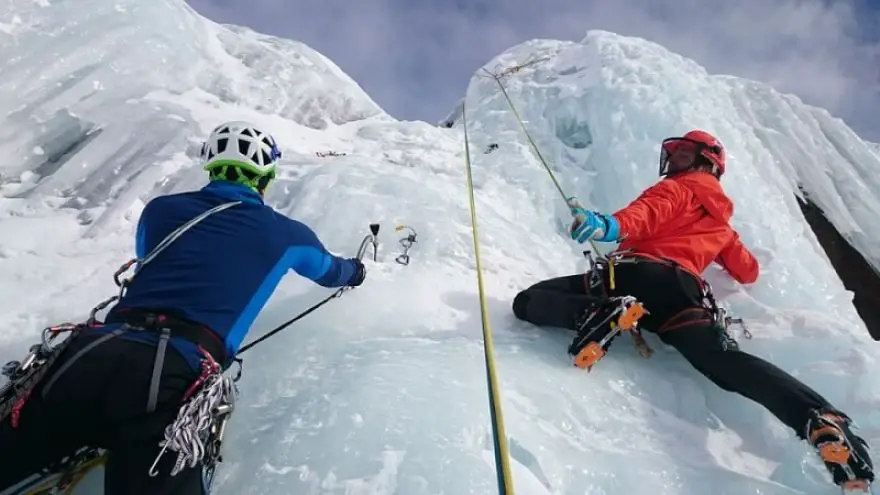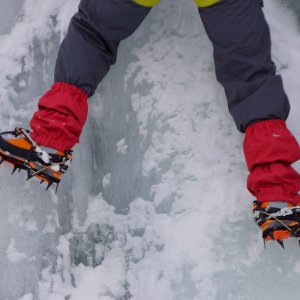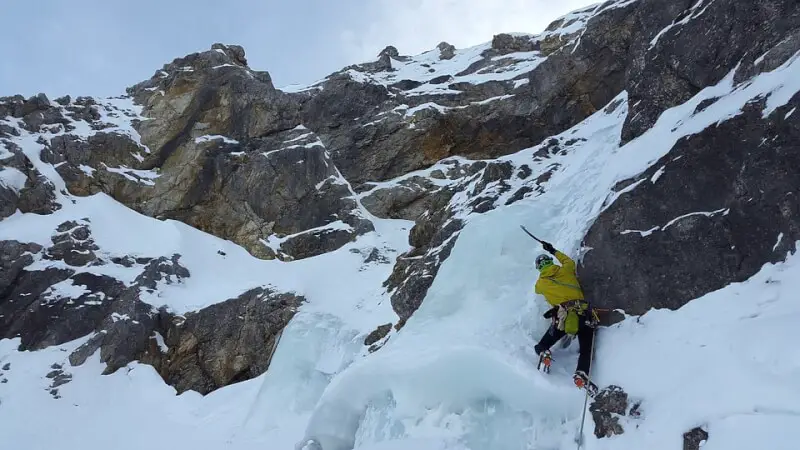How to Choose Ice Climbing Gear
 How to Choose Ice Climbing Gear
gearweare.net
How to Choose Ice Climbing Gear
gearweare.net
Picking the right gear for the activities that one does is a critical part of maximizing one’s ability and comfort in the outdoors. This is especially true within the sport of ice climbing, which can be quite dangerous if any key piece of gear is missing. This doesn’t just apply to the equipment you will need to safely climb ice, but also to what you wear as you climb. This is because scaling vertical ice requires spending elongated periods of time out in the cold. Without proper clothes, one may become dangerously cold and runs the risk of developing cold weather complications like hypothermia and frostbite.
Furthermore, the discipline of ice climbing requires special tools besides what is needed for rock climbing. These tools are similar to what is used on alpine ascents of snow covered mountains, however, they are slightly different and these dissimilarities can make a big difference. The novice ice climber will be able to utilize some of their partner’s ice climbing gear, but a firm grasp on everything that is needed and how to choose the right style of each tool and piece of equipment is necessary if one wants to stay safe and retain partners for the long haul. Read on to learn more about ice climbing equipment and how to choose the equipment that is right for you.
Table of Contents
 Crampons
Crampons
This is one of the most important tools that you will use while ice climbing, which allows you to get traction and create ledges in ice in a way that would otherwise be impossible. It should be noted that the crampons one uses to ascend steep terrains, like a glacier or mountain, differ from those you will want climbing vertical ice.
Mountaineering crampons can be made from softer materials, such as aluminum, and do not need spikes in the front. The spikes in the front are necessary for ice climbing though, as they allow one to “front-point”, which is the common ice climbing method of kicking these spikes into the ice and then using that as a step to stand upon. Harder metals, like steel, are also preferable as they will stand up to more wear and tear.
Now that you know the difference between mountaineering and ice climbing crampons, you should think about the specific type of ice climbing that you do. Dual-point, which have more than one spike in the front, is ideal for those who are new to the sport or know that they what they do requires more stability than precision. Mono-point crampons offer greater accuracy in where they are placed but also require greater skill to be utilized properly. The precision offered by this second type, which logically only has one spike in the front, is especially handing when moving between ice and rock on a mixed climb.
Boots
Crampons cannot be worn by themselves but must be utilized with a pair of compatible boots. Although typical, leather mountaineering boots can work, there are also boots on the market that are specifically made for the sport of ice climbing. The differences are that these boots are designed to maximize warmth and to keep your heel in place as you climb. For this reason, they are often much stiffer than their counterparts that are designed for a variety of activities in the mountains. Ice climbing boots must also be fully waterproof.
Ice Tools
Ice tools are the super cool looking pieces of equipment that ice climbers hold as they ascend a rout. These are a critical piece of gear since the ice tools stuck into the ice is what provides a climber with handholds to ascend. Without them, ice climbing would pretty much be impossible.
Just as the crampons that one uses for ice climbing differ from those used while mountaineering, alpine ice axes must be differentiated from ice climbing ice tools. The primary difference is the length. Ice tools are must shorter, which makes the versatile as you swing them and pull up, while ice axes are longer and work more like a sharp walking stick. Ice tools are curved, which allows for a more efficient swing. For ice climbing, you will also want to make sure to use ice tools with a reverse curve on the pick, and a hammer at the end. For the most part, most ice climbers avoid tethering their ice tools to themselves since this can hamper movement and creates greater danger if a fall occurs.
Other Ice Climbing Specific Gear
There are a few things that will be included on your rack which are only applicable to ice climbing. Namely, ice screws are how ice climbs are protected and are something that every ice climber should have even if you only top rope. This is because many anchor systems are built from ice screws. An ice screw holder and a v-thread hook will also be quite useful.
The ropes that ice climbers use also differ slightly from other types of climbing. A dry rope is a must, as any water in the rope may cause it to freeze, making it stiff and unusable. Depending on what type of ice climbing you are doing you may also want to use a twin rope.
General Climbing Gear
The harness, helmet, quickdraws, belay device, locking carabiners, slings, and webbing that you typically use while rock climbing will also work well for ice climbing.
Clothing
A typical, three-part layering system should be used for ice climbing. This includes a moisture-wicking bottom layer, an insulating mid-layer, and a water and wind repellent outer layer. Furthermore, you may want to bring more clothes to cozy up in on super cold days while belaying. Accessories, including a hat, face mask, and waterproof gloves are also critical for staying warm while ice climbing. Bring more than one pair of gloves to ensure that your hands will stay warm even if the first pair gets wet.












